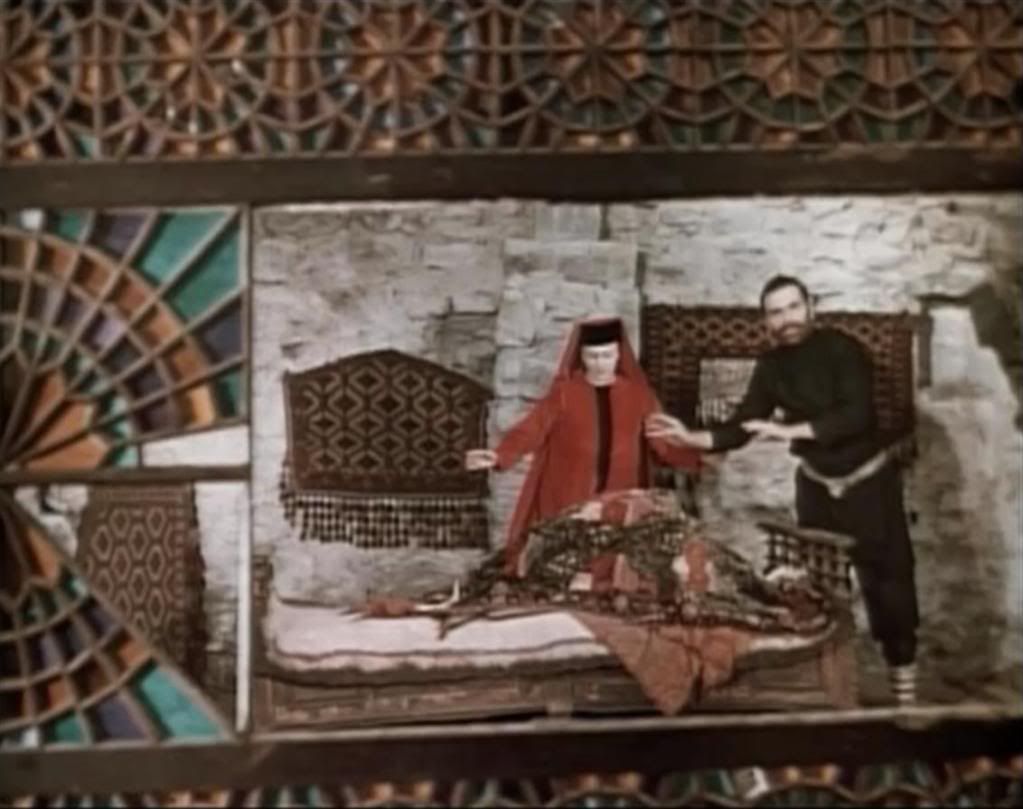
Sergei Parajanov's The Color of Pomegranates is an extraordinarily challenging film inspired by the 18th Century poet Sayat-Nova. The film is loosely based around the poet's life, but rather than relating a conventional biographical narrative, Parajanov's film is almost entirely visual and abstract, translating the subject's life and poetry into a purely visual language. Snippets of Sayat-Nova's words are read aloud or appear onscreen at various points throughout the film, but for the most part this is a strictly non-verbal movie, its images apparently drawn from the imagery of Sayat-Nova's poems so that the film becomes a cinematic poem rather than a mere biography of the poet.
The result is that Parajanov's work will inevitably be all but impenetrable and obtuse except to those already well-versed in the life and work of the film's subject. It's a very challenging and boldly avant-garde film that seeks to communicate feelings and sensations rather than concrete facts. The broad outlines of Sayat-Nova's life story are apparent here — starting with his boyhood memories and intimations of a young romance before he enters a monastery — but the emphasis is on the evocative visual poetry of Parajanov's aesthetic.

The film's look is influenced by the textual illuminations of religious texts, several of which appear within the film to confirm the visual reference point. Each shot is static and stagey, with Parajanov meticulously arranging theatrical tableaux in which symbolic figures enact strange rituals, often while staring, disconcertingly, into the camera. Blank white stucco walls are like the margins of the page in an ancient manuscript, while these figures in their elaborate, colorful costumes pose and contort themselves. Religious imagery proliferates throughout the film, as does Armenian folk art in the form of the old-fashioned garments and rugs that adorn the film's various tableaux. Parajanov is paying tribute to the culture and traditions of the region as much as to this particular poet, as evidenced by the emphasis on the scenes of animal sacrifices, dying of wool, and other rural pursuits.
A major theme running through the film is the opposition between sensuality and spirituality. As a boy, the poet (played as a child by Melkon Alekyan) witnesses scenes of tremendous sensuality, particularly in a voyeuristic sequence in which he peers into a bath house, where men are caked in mud and showered with water from urns, poured on them from overhead. The boy also gambols among the washerwomen, and Parajanov trains his camera on the women's bare feet, jogging along the wet ground as they scurry back and forth doing their work, their bare feet and ankles contained within the frame. Most potently, there's an image of a woman's naked torso, a seashell cupped over one of her breasts, a searing and strange image of sexual promise that seems to have great meaning for Parajanov, and for Sayat-Nova: the image is repeated several times, and the poet himself repeats the gesture at certain points by placing a seashell over his own chest, connecting him with the woman, whoever she was.

As a slightly older youth, Sayat-Nova falls in love, but he seems to reject sensuality and sexuality and enters a monastery instead, opting for a life of asceticism and restraint. (In fact, the poet was exiled from the court of the Georgian king Erekle II after falling in love with the king's sister.) Sensual temptations still plague him, though: a pair of nuns look at the handsome young monk and swoon with desire, alternating between hiding themselves behind thick rugs and lowering the rugs to peek out at him, succumbing to the same voyeuristic impulses that had caused the young Sayat-Nova to peep into the bath house. Later, a woman in a white nightdress and nun's habit leans over to kiss the monk/poet, but he holds up a rug between them, its thick fabric separating their bodies and their lips.
The film's romanticism and sensuality are further enhanced by the decision to have a single actress, Sofiko Chiaureli, play both the poet and his lover in their youths, androgynously embodying both genders as well as appearing in more symbolic guises later in the film. The Color of Pomegranates is a dense, baffling work, beautiful and strange, and utterly unlike anything else in the cinema. It's as intensely poetic as its subject, exploring the conflicting passions and religious feelings of the poet, as well as his deep connection with the traditional lifestyle he experienced as a child.

3 comments:
An absolute masterpiece. Paradjanov was a great cinematic poet -- and a great martyr to truth.
He spent several years in prison for "homosexuality" and "incitement to suicide" (which apparently is direct result of being gay.
A staggering masterpiece, and Paradjanov's most celebrated film. Ed, I know avante garde cinema is a specialty of yours and you give this film remarkable passion and scholarly heft in your fabulous essay. This is as poetic as any film in the cinema, and I quite agree about the proliferace of religious imagery, and the opposition between sensuality and spirituality! This is also as you note a film unlike any other in the cinema. Paradjanov's incarceration contributed to the decline of his health and death. His earlier film SHADOWS OF FORGOTTEN ANCESTORS is another ravishing masterwork.
This film has been waiting for me for a long time... and I think the time has come for me to finally watch it - this essay pushed me over the tipping point.
(Sorry about the English. I hope I didn't miss the expressions... too much.)
Post a Comment